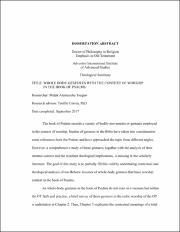Whole-body gestures with the context of worship in the book of Psalms
Abstract
The book of Psalms records a variety of bodily movements or gestures employed
in the context of worship. Studies of gestures in the Bible have taken into consideration
some references from the Psalms and have approached the topic from different angles.
However, a comprehensive study of these gestures, together with the analysis of their
internal context and the resultant theological implications, is missing in the scholarly
literature. The goal of this study is to partially fill this void by undertaking contextual and
theological analysis of ten Hebrew lexemes of whole-body gestures that have worship
context in the book of Psalms.
As whole-body gestures in the book of Psalms do not exist in a vacuum but within
the OT faith and practice, a brief survey of these gestures in the cultic worship of the OT
is undertaken in Chapter 2. Then, Chapter 3 explicates the contextual meanings of a total
of 45 occurrences of the ten Hebrew lexemes for whole-body gestures in 26 psalms.
Among these, הלך denotes the journey to reach the sacral space in the city of God.
Having reached the temple mount, the worshipers will go up ( עלה ) the mountain of
YHWH. בוא signfies the movement into the premises of YHWH’s abode. The two
occurrences of סבב portray a circular movement of the worshipers around the altar of
God as they enter the temple and their marching around Zion as they depart from the holy
city. מחול refers to dancing in a ring or a circle that takes place in the procession to the
temple. Also, those who are called to engage in this gesture are identified as the ,חָסִיד
“pious, godly” (Ps 149:1, 5), and the holiness of YHWH is emphasized (Pss 30:5; 149:2;
150:1).
The Hebrew words ברך, כרע , and חוה signify the movement of lowering the
body from an erect posture. In fact, a progression could be noted in these three lexemes,
bowing low ( כרע ), kneeling ( ברך ), and prostration ( חוה ). Having prostrated themselves in
the presence of YHWH, worshipers arise ( קום ) and stand ( עמד ) before YHWH.
A closer study of the internal context of these ten Hebrew lexemes reveals a
theological framework that connects physical actions in worship with the attitudes of the
worshiper and the attributes of YHWH. Based on this framework some principles of
worship that have practical implications on the experience of worshipers are deduced in
Chapter 4. Lastly, Chapter 5 offeres a summary of the findings of the research, some
conclusions, and recommendations.


